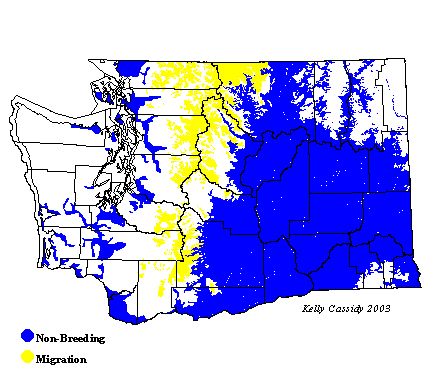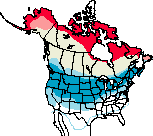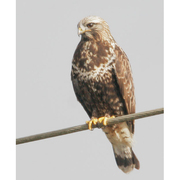Rough-legged Hawk
General Description
This winter visitor is a large, soaring hawk named for the feathers that extend down its legs, an adaptation to its northern habitat. Rough-legged Hawks are variable in plumage, with light and dark color phases and variations in between. Dark phases account for only ten percent of western Rough-legged Hawks. Adults are generally mottled light-and-dark underneath, with dark patches at the wrists. Seen from below, the tails of both phases appear light with a dark terminal band. Seen from above, both phases appear mostly dark, but the light phase shows a light tail with a dark terminal band, and the tail of the dark phase appears dark all over. The adult male can have several dark bands at the tip of its tail as compared to the female, which only has one band. The light phase has a distinctive light-colored head, in contrast to its dark upperside. The Rough-legged Hawk's bill and feet are relatively small.
Habitat
Rough-legged Hawks nest in the Arctic, both in the Old and the New World, mostly in tundra. They also use the northern edge of boreal forest. In winter, they inhabit open fields, plains, marshes, and farmland.
Behavior
They are usually found singly or in pairs; only rarely are they seen in large groups. They hunt by watching from a perch. Because of their small feet, they are able to stand on a thin perch. They patrol low over the ground, or hover high over a field, watching for movement, then swooping down, talons first, to grab prey.
Diet
On the breeding grounds of the Rough-legged Hawk, lemmings are an important food source. Voles, mice, ground squirrels, and other small mammals are part of the diet at other times of the year. They have also been known to eat carrion, especially in the winter.
Nesting
Nests are built on cliffs, slopes, atop large rocks, or on the ground, or, when there are trees nearby, in a tree. The bulky nest is made of sticks, bones, and other debris, lined with twigs, grass, and other fine material. The female incubates the 3 to 5 eggs for 31 days while the male brings her food. The female broods the young, and the male continues to provide them all with food. After a few weeks, the female joins in the hunting. The young first begin to fly at 5 to 6 weeks of age, but remain with the adults for another 3 to 5 weeks.
Migration Status
Birds leave their Arctic breeding grounds in late fall, with only a few migrating farther south than the central United States. Migrants come to Washington from points north, usually from early October throughout November. The birds return to the Arctic early in spring.
Conservation Status
Rough-legged Hawk populations vary considerably from year to year, following the population cycles of their lemming prey. These fluctuations make it difficult to assess trends, but Christmas Bird Count data reflect an increase throughout the Northwest over the past 30 years, and the population appears to be healthy.
When and Where to Find in Washington
Every winter Rough-legged Hawks move into eastern and western Washington, and can be found in many large, open habitats. During migration, they can also be seen in the mountains. A few southbound birds are seen as early as mid-August, but they are not common until mid-October. By mid-April they are uncommon, and are not generally seen in Washington after the end of April. Numbers vary greatly from year to year due to prey availability.
 Abundance
Abundance
| Ecoregion | Jan | Feb | Mar | Apr | May | Jun | Jul | Aug | Sep | Oct | Nov | Dec |
|---|---|---|---|---|---|---|---|---|---|---|---|---|
| Oceanic | ||||||||||||
| Pacific Northwest Coast | U | U | U | R | R | U | U | |||||
| Puget Trough | F | F | F | U | R | U | F | F | ||||
| North Cascades | ||||||||||||
| West Cascades | U | U | U | R | U | U | ||||||
| East Cascades | R | R | R | R | R | R | R | |||||
| Okanogan | F | F | F | U | R | R | F | F | F | |||
| Canadian Rockies | F | F | F | U | U | F | F | |||||
| Blue Mountains | U | U | R | U | U | |||||||
| Columbia Plateau | F | F | F | F | R | R | F | F | F |
Washington Range Map

North American Range Map


Family Members
 OspreyPandion haliaetus
OspreyPandion haliaetus White-tailed KiteElanus leucurus
White-tailed KiteElanus leucurus Bald EagleHaliaeetus leucocephalus
Bald EagleHaliaeetus leucocephalus Northern HarrierCircus cyaneus
Northern HarrierCircus cyaneus Sharp-shinned HawkAccipiter striatus
Sharp-shinned HawkAccipiter striatus Cooper's HawkAccipiter cooperii
Cooper's HawkAccipiter cooperii Northern GoshawkAccipiter gentilis
Northern GoshawkAccipiter gentilis Red-shouldered HawkButeo lineatus
Red-shouldered HawkButeo lineatus Broad-winged HawkButeo platypterus
Broad-winged HawkButeo platypterus Swainson's HawkButeo swainsoni
Swainson's HawkButeo swainsoni Red-tailed HawkButeo jamaicensis
Red-tailed HawkButeo jamaicensis Ferruginous HawkButeo regalis
Ferruginous HawkButeo regalis Rough-legged HawkButeo lagopus
Rough-legged HawkButeo lagopus Golden EagleAquila chrysaetos
Golden EagleAquila chrysaetos

